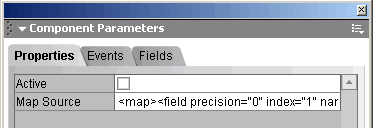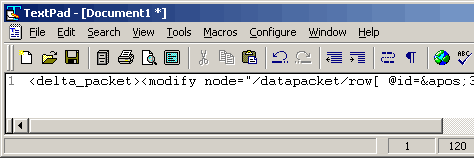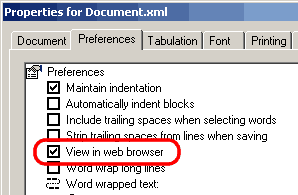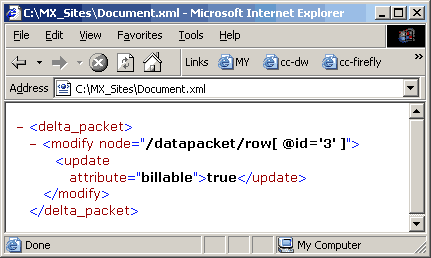|
XML generated in output window or visual
property editor
At times developers may want
to see Firefly-generated XML in a more convenient
format than Firefly offers. Features such as color
coding of XML code, line breaks, and indentation
may be needed in these instances.
Two instances in which
Firefly generates XML inside of Flash are when
creating a map file in the FxDataSet visual
property editor and viewing the trace output for a
DeltaPacket in the TimeTrax tutorial. This XML is
usually in the format of one long string, and in
the visual property editor it's displayed in a
small text box that hides most of the text from
view. What
is a Firefly map file?
When working with XML data in Firefly, the
data must be mapped into an FxDataSet. The mapping
information is stored as XML and referred to as a
Firefly map file. There are several ways to create
and use a map file:
| 1 |
Use the FxDataSet component visual
property editor to create the FxDataSet fields,
set default properties, and map them to a node
in an XML file. |
| 2 |
Manually create an XML mapping file using
your favorite XML or text editor.
|
| 3 |
Point to an existing Firefly map file on
a server or hard disk using the Map Source
property of the FxDataSet component.
|
For more information about creating map
files, see the Firefly documentation:
Firefly Components Help > Tutorials
> Advanced Topics > Map XML using the
FxDataSet.
If using option 1 to create the map file,
Firefly will generate the Map Source XML for you,
however, it's displayed in a small text field in
the Properties tab of the FxDataSet's visual
property editor, as shown below:

XML in the trace output
window
Developers frequently create functions to
display XML generated in Flash, using this for
informational or debugging purposes. This allows
developers to see the XML that Flash sends to
other applications.
For example, in the TimeTrax tutorial that
ships with the Firefly Components there is a
button named Show DeltaPacket. When you run the
application in Test Movie, make changes to the
grid, and then click the Show DeltaPacket, a trace
output window appears showing the XML generated
for the DeltaPacket. However, the XML file is
displayed as one long string, making it difficult
to visualize the XML structure.

How can I view the Map Source XML and
trace output XML in an easier to read
format?
To view the Map Source XML or trace output
XML code for troubleshooting or learning purposes
follow this mini-tutorial.
| 1 |
Download TextPad for free from textpad.com or download.com, and install it
on your local machine. Any preferred text editor
can also be used. |
| 2 |
Download Internet Explorer 6 from the Microsoft website. This
browser is useful since it parses the XML and
displays it on the screen in an easy to read
tree format. If using another browser, you may
have to view the page as source code to see the
XML format. |
| 3 |
Launch TextPad or another text editor.
|
| 4 |
Launch Flash and open the visual property
editor for the FxDataSet component, as shown in
the image of the Component Parameters dialog box
above. |
| 5 |
Highlight all text inside the Map Source
field or trace output window. In the visual
property editor, you can alternatively
right-click and choose Select All.
|
| 6 |
Once the XML code is highlighted,
right-click and choose Copy. In the trace output
dialog box, you can alternatively click the
Options drop-down menu and choose Copy.
|
| 7 |
Switch to TextPad, open a new file and
paste the XML code. |
| |
 |
| 8 |
Save the XML file giving it a .xml
extension (e.g. myFile.xml). |
| 9 |
Right-click anywhere in the body of the
XML file and choose Properties.
|
| 10 |
In the Properties dialog box select the
Preferences tab and check the checkbox labeled
View in Web Browser. Click OK. |
| |
 |
| 11 |
You should now be able to right-click
again anywhere in the body of the XML file,
choose Properties and then choose View in Web
Browser. |
| 12 |
Internet Explorer 6 should launch
displaying the XML file generated by Firefly.
Internet Explorer color codes the XML and allows
you to expand and collapse the XML nodes for
easier viewing. |
| |

|
Note:
Macromedia does not provide technical
support for third-party products, such as TextPad.
If you have TextPad configuration questions,
please consult the TextPad documentation or
contact TextPad technical support.
|